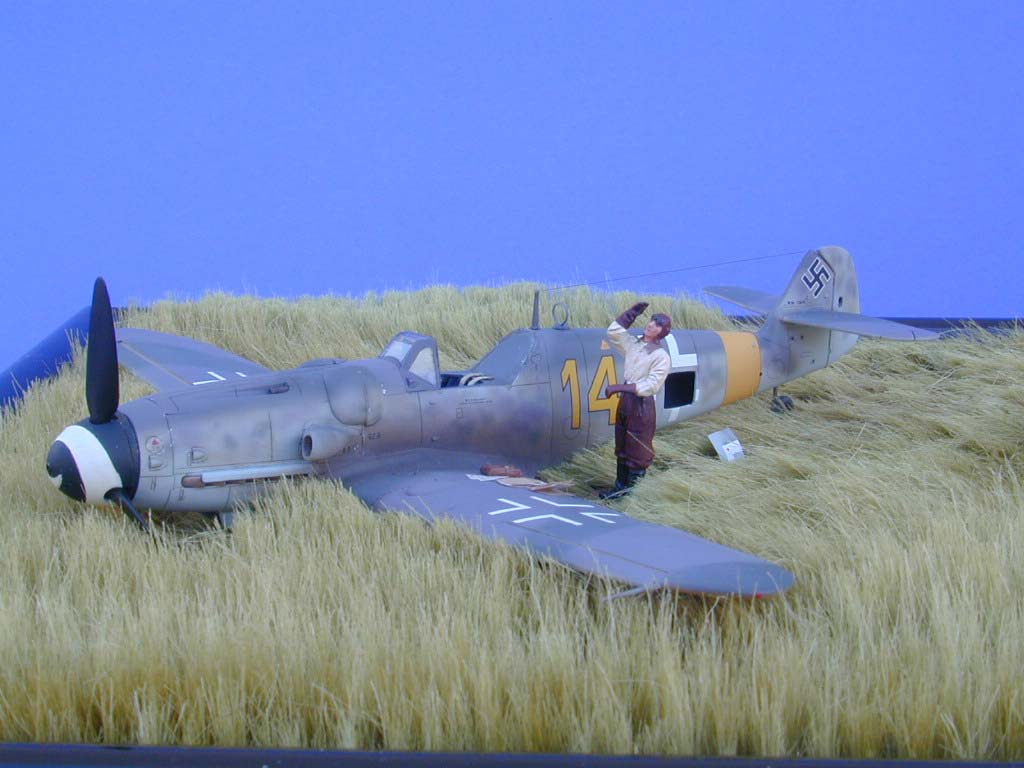Lee has sent me three photographs of a very special Bf109G-8 diorama...I'll let him tell the story. This is worth a read, and it's a reminder of why a lot of us enjoy this hobby so much- it's an opportunity to connect with these warriors of long ago.
Here is a project that my club did for a local veteran, Oblt. Helmuth Löwe. He was a reconnaissance pilot that flew Bf 110s, Me 410s, and Bf 109s on both the eastern and western fronts from 1943 to 1945. He was a minor ace (five victories, all VVS aircraft), and was one of the few Luftwaffe pilots that actually managed to fly over the Normandy beachhead on June 6 to snap photos. Helmuth served until the very last day of the war, which is the subject of this diorama.
He was officially told to fly to a base in the east, but his commander issued the pilots all of their files and papers (an unusual act) and with a wink, told them to fly west. From Czechoslovakia, Helmuth flew towards his hometown in western Germany to be with his wife and six-month-old daughter, who he had never seen. He had to dodge several P-47s and P-51s on patrol enroute, darting into cloud banks to avoid being intercepted. Circling his house, his wife looked up the in air, saw Helmuth, and placed the baby in the open window for him to see, waving joyously. Comforted by the fact that his family was safe, Helmuth then began looking for a suitable place to put his Bf 109G-8 "Yellow 14" down.
A nearby American infantry group spotted the low-flying plane and opened fire. Helmuth's rudder was hit, seriously affecting his ability to control the aircraft. Helmuth released the canopy and decided to belly-land his damaged plane in a wheat field, all the time trying to avoid the American anti-aircraft fire. He wrestled the aircraft down into the field successfully, crushing the newly-planted wheat underneath. When the plane stopped, he took all his papers out of the storage compartment and laid them out on the port wing. By then the American soldiers arrived and immediately commenced stripping everything off of Helmuth for souvenirs. A few minutes later an officer arrived and ordered the troops to give Helmuth back his clothes and began to process him as a prisoner of war. When Helmuth told the officer that he was flying back to see his family, the officer drove Helmuth to his home and let him see his wife and daughter for twenty minutes before he was whisked off to a POW camp. Two weeks later he was released and war was officially over for him.
The model is the 1/48 scale Hasegawa Bf 109G-6 modified to a photo-recon G-8. A real group project, members of IPMS Eagle Squadron all pitched in to make it come to fruition. Amateur historian Michael Wegner initially befriended Helmuth and did the research of the event. William Reece did the cockpit and the battle damage. Lee Kolosna assembled the model and made the file folders and papers on the wing. Rick DeNatale painted the propeller and the canopy. Lee Griffin painted, decaled, and weathered the model and also painted the figure. Ronnie Murray constructed the base, and the beleaguered Norm Samuelson spent two weeks applying the individual stalks of railroad grass to the base to simulate the young wheat. The completed diorama was presented to Helmuth and his wife in 1999.
Sadly, Helmuth passed away last summer after living for many years in Raleigh, NC.


